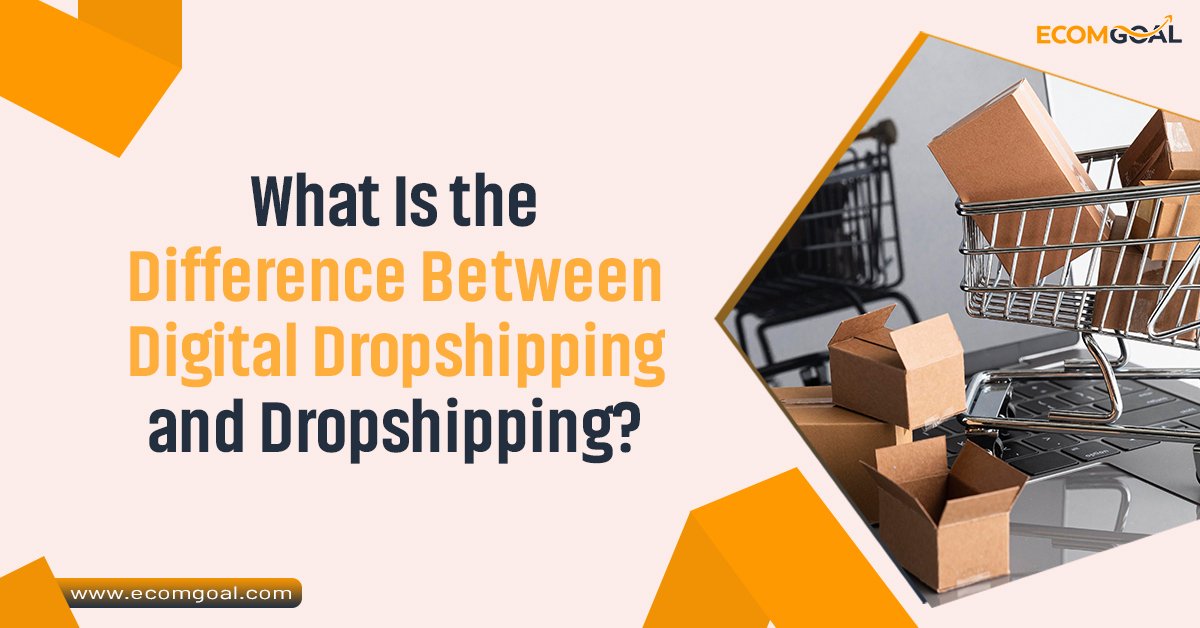
What is the difference between digital dropshipping and dropshipping? dropshipping has become a popular business model for entrepreneurs wanting to start an online store without the hassle of managing physical inventory. With dropshipping, you sell products online, and when a customer makes a purchase, the supplier ships the product directly to the customer. This eliminates the need to invest in large quantities of stock, handle warehousing, or manage logistics. However, as e-commerce evolves, so do the methods used. One variation that’s gaining attention is digital dropshipping. But what exactly sets digital dropshipping apart from traditional dropshipping?
In this article, we’ll explore what is the difference between digital dropshipping and dropshipping these two business models, their pros and cons, and how to decide which is best suited for your goals.
Step-by-Step Guide What Is the Difference Between Digital Dropshipping and Dropshipping
What is Traditional Dropshipping?
Traditional dropshipping is a retail fulfillment method where an online store does not keep the products it sells in stock. Instead, it purchases the item from a 3rd-party supplier who then ships it directly to the customer. This process allows you to offer a wide range of physical products without managing inventory or dealing with the logistics of shipping.
Here’s a breakdown of how traditional dropshipping works:
- You set up an online store (typically on platforms like Shopify, WooCommerce, or BigCommerce).
- You choose physical products to sell, often from suppliers on platforms like AliExpress, Oberlo, or SaleHoo.
- When a customer orders a product, you purchase the product from your supplier, who ships it directly to your customer.
Advantages of Traditional Dropshipping:
- Low startup costs: You only pay for products once you’ve sold them, which reduces initial investment.
- Flexible product selection: You can test various products to find what sells best.
- Reduced risk: Without holding inventory, you avoid issues like dead stock or storage costs.
Disadvantages of Traditional Dropshipping:
- Longer shipping times: Many suppliers are located overseas, leading to delays.
- Slimmer profit margins: The market for physical products is competitive, often leading to lower profit margins.
- Reliance on third-party suppliers: If suppliers run out of stock, it can impact your business.
What is Digital Dropshipping?
Digital dropshipping is a more recent take on the dropshipping model but is distinct from traditional methods in key ways. Instead of selling physical products, you sell digital products—items that customers can download or access instantly, such as e-books, software, online courses, stock images, music, or templates. This model allows you to serve a global audience without shipping or logistics concerns.
Here’s how digital dropshipping works:
- You create an online store or a platform to market digital products.
- You collaborate with creators or license owners to list their digital products.
- When a customer makes a purchase, they receive immediate access to download the product or a link to access it.
Examples of Digital Products for Dropshipping:
- E-books and audiobooks
- Software or app plugins
- Templates (for websites, resumes, graphics)
- Online courses and tutorials
- Stock photos and videos
Advantages of Digital Dropshipping:
- Instant delivery: Customers receive digital products immediately, eliminating wait times.
- High-profit margins: Digital products often have higher profit margins because there are no production or shipping costs.
- No storage costs: Since digital products are stored in the cloud, there’s no need for physical storage space.
- Scalability: Digital dropshipping is highly scalable because delivery is automated.
Disadvantages of Digital Dropshipping:
- Limited product categories: Digital products might not appeal to every customer base, limiting options.
- Potential copyright issues: Digital products can sometimes be easily copied or pirated, so copyright protection is essential.
- Higher customer service expectations: Customers may require more guidance on using digital products, especially with software or courses.
Key Differences Between Digital Dropshipping and Traditional Dropshipping
Aspect Traditional Dropshipping Digital Dropshipping
- Product Type Physical goods Digital products
- Shipping Requirements Required Not required (instant delivery)
- Profit Margins Lower, due to competition Higher, due to low overhead
- Delivery Time Often lengthy Instant
- Storage Needs Required (through suppliers) None (cloud-based)
- Customer Support Minimal (order inquiries) May require more guidance
Pros and Cons of Digital vs. Traditional Dropshipping
Pros of Digital Dropshipping
- Faster Delivery: Digital products are delivered instantly, enhancing customer satisfaction.
- Higher Profit Margins: Since there are no costs for production or shipping, profit margins are typically higher.
- Automation-Friendly: Digital downloads can be automated, reducing the need for manual handling.
Cons of Digital Dropshipping
- Limited Market Appeal: Not all customers are looking for digital products, and certain niches may not fit well with digital offerings.
- Risk of Piracy: Digital products are easy to copy, so protecting intellectual property is a concern.
- Higher Refund Rates: Customers may request refunds more frequently, especially if they don’t understand the value of digital products initially.
Pros of Traditional Dropshipping
- Wider Product Variety: Physical products appeal to a broader audience, so you can offer everything from apparel to electronics.
- More Established: Traditional dropshipping has been around longer, with numerous tools and resources available to assist.
- Higher Market Demand: Physical goods are still in high demand, offering a broader customer base.
Cons of Traditional Dropshipping
- Long Shipping Times: Many suppliers operate internationally, which can lead to extended delivery times.
- Smaller Profit Margins: Due to competition and lower perceived value, profit margins are often lower.
- Dependency on Suppliers: If suppliers fail to deliver on time, it can negatively affect your reputation.
Which Model Is Right for You?
Both digital and traditional dropshipping models have unique benefits and drawbacks, and choosing the best model for your business depends on your goals and resources.
- If you prefer lower risk and no inventory management: Digital dropshipping might be ideal for you, especially if you are tech-savvy and enjoy selling products that require minimal shipping.
- If you want broader product variety and appeal: Traditional dropshipping offers flexibility in product choice, making it easier to cater to different customer needs.
- If you value immediate delivery and higher margins: Digital dropshipping is ideal, as it allows for instant fulfillment and can be highly profitable with the right products.
- If you want an established, more straightforward business model: Traditional dropshipping might be a better option, as it is a tried-and-true method with plenty of resources and support available.
Conclusion
Understanding what is the difference between digital dropshipping and dropshipping is key to choosing the right path for your e-commerce venture. Traditional dropshipping is best for those who want to sell physical goods with a wide range of product options, while digital dropshipping is suited to those who want to work with digital products and enjoy the benefits of instant delivery, higher profit margins, and scalability.
Consider your niche, target audience, and business goals. By understanding the unique characteristics of each model, you can build a successful, profitable dropshipping business that aligns with your strengths and ambitions. Whether you opt for traditional or digital, both models offer unique opportunities to grow a successful online business.

Hello, I am an E-commerce Expert with extensive experience providing services to numerous e-commerce brands and individuals since 2017. My primary areas of expertise include the Amazon, Walmart, and Shopify marketplaces. Linkedin
